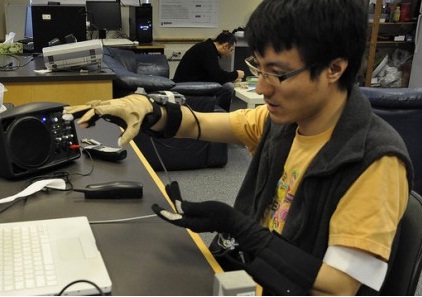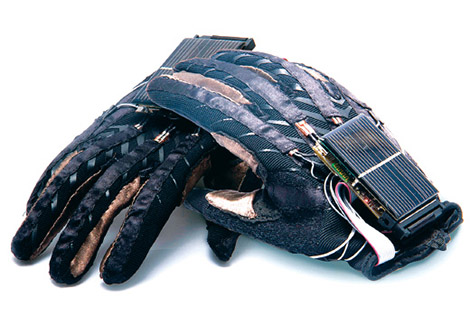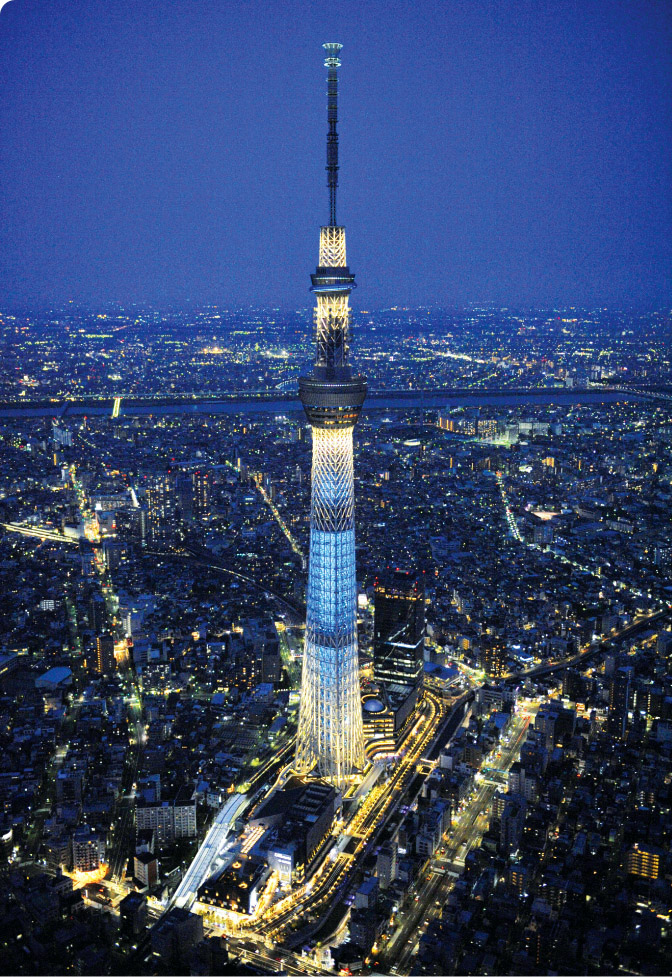Posted on November 27th, 2013 by Mary Lord
 What’s in a voice? A new gesture-to-speech synthesizer developed by researchers at the University of British Columbia adds emotion to words that text-to-speech technologies now voice only in a monotone. It also translates gestures into music.
What’s in a voice? A new gesture-to-speech synthesizer developed by researchers at the University of British Columbia adds emotion to words that text-to-speech technologies now voice only in a monotone. It also translates gestures into music.
Read More
Filed under: Computer, Electrical, Explore Engineering | Comments Off on Talk to the Hand
Tags: Electrical, Felix Tang, gesture-to-voice, hand, Music, Music engineering, mute, sensors, Sidney Fels, sign language, synthesizer, University of British Columbia
Posted on April 3rd, 2013 by Mary Lord
 FIRST Robotics competitions, Botball tournaments, Mars rover demonstrations, fun events at colleges… How will you celebrate National Robotics Week this year?
FIRST Robotics competitions, Botball tournaments, Mars rover demonstrations, fun events at colleges… How will you celebrate National Robotics Week this year?
Read More
Filed under: Electrical, Explore Engineering, Mechanical | Comments Off on National Robotics Week 2013
Tags: BotBall, Events, intelligent machines, National Robotics Week, Robotics, robotics competitions, robots
Posted on February 21st, 2013 by aseeadmin

Sudden infant death syndrome, or crib death, is responsible in the United States for around 2,225 deaths a year of children from birth to 12 months. But German researchers have developed a stretchable, printed circuit board that could be fitted into a one-piece sleeper and would signal an alarm if a baby stops breathing. Investigators at the Fraunhofer Institute for Reliability and Microintegration IZM in Berlin have figured out how to make the flexible, wearable circuit board from polyurethane, a plastic often used as a sealant. They fitted it with sensors that monitor breathing in the chest and stomach areas, and ironed it onto baby-size PJs.
Read More
Filed under: Biomedical, Chemical, Computer, e-News, Electrical, Explore Engineering, Industrial / Manufacturing, Materials, Mechanical | Comments Off on Smart Jammies
Posted on November 29th, 2012 by aseeadmin

Some engineers just can’t wait until they graduate to start innovating. Here’s one recent example: After watching a man with a speech impairment struggle to make a supermarket cashier understand him, three Ukrainian computer science students, who call themselves the QuadSquad, designed gloves fitted with 15 sensors that can understand the hand and finger gestures used in sign language.
Read More
Filed under: Computer, e-News, e-Videos, Electrical, Explore Engineering, Industrial / Manufacturing, Materials | Comments Off on Student Innovation: EnableTalk
Posted on November 8th, 2012 by aseeadmin

Tokyo’s new 2,080-foot Sky Tree, the world’s tallest broadcast tower, is projected to draw 32 million visitors a year. But tourists won’t see one of its most striking features – a design intended to survive severe earthquakes and catastrophic winds.
Engineers began by studying soil formation as deep as 1.8 miles and taking meteorological measurements using a radiosonde balloon.
Read More
Filed under: Architectural, Civil, e-News, e-Videos, Electrical, Explore Engineering, Materials, Mining | Comments Off on No Toppling This Tower
 What’s in a voice? A new gesture-to-speech synthesizer developed by researchers at the University of British Columbia adds emotion to words that text-to-speech technologies now voice only in a monotone. It also translates gestures into music.
What’s in a voice? A new gesture-to-speech synthesizer developed by researchers at the University of British Columbia adds emotion to words that text-to-speech technologies now voice only in a monotone. It also translates gestures into music. 








 FIRST Robotics competitions, Botball tournaments, Mars rover demonstrations, fun events at colleges… How will you celebrate National Robotics Week this year?
FIRST Robotics competitions, Botball tournaments, Mars rover demonstrations, fun events at colleges… How will you celebrate National Robotics Week this year?

